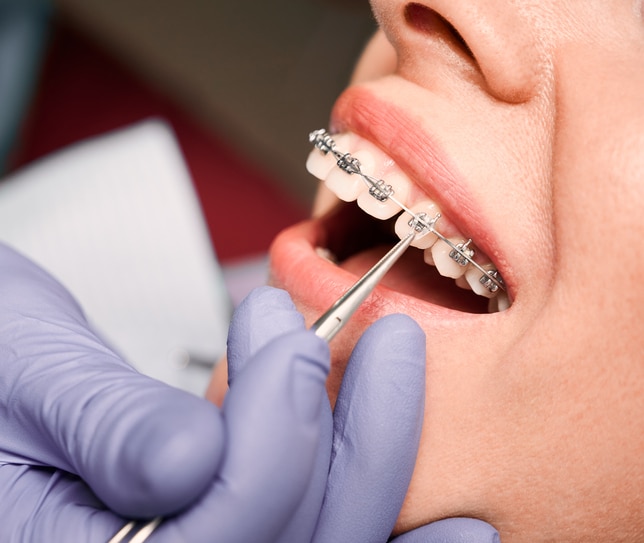Comprehensive Guide to Orthodontics Treatments for Fixing Dental Misalignments
In the world of orthodontics, the trip to accomplishing a flawlessly straightened smile includes a myriad of treatments customized to correct dental misalignments. From conventional dental braces to unnoticeable aligners and also surgical options, the field of orthodontics uses a variety of options to resolve varying degrees of dental irregularities. Understanding the ins and outs of each treatment, including their devices, benefits, and potential disadvantages, is crucial in making educated choices concerning one's orthodontic therapy. As we browse via the comprehensive guide to orthodontic treatments for remedying dental misalignments, the elaborate details of each method will certainly unravel, losing light on the course towards a practical and harmonious dental positioning.
Orthodontic Procedures Review

In addition to clear aligners and traditional braces, orthodontists may additionally suggest various other interventions like headwear, palatal expanders, or retainers to resolve details positioning problems (cumming braces). These treatments are tailored to each patient's special needs and might involve a mix of therapies to achieve the wanted results. Normal modifications and tracking are essential parts of orthodontic therapy to make certain development is on track and to make any type of essential modifications along the road. By undertaking orthodontic procedures, patients can not just attain a straighter smile however likewise enhance their general oral wellness and function.
Traditional Braces: How They Work
When considering orthodontic treatments for oral misalignments, conventional braces stand out as a time-tested method for correcting teeth positioning. Typical braces are composed of braces, wires, and bands that function together to use continuous pressure on the teeth, progressively moving them into the wanted positioning.
One secret facet of how standard braces work is the process of bone improvement. As pressure is related to the teeth through the braces, the bone bordering the teeth is improved to sustain the new tooth settings. This remodeling is essential for the lasting security of the fixed placement. Patients will certainly require regular modifications at the orthodontist's office to make sure the braces continue to use the proper pressure for effective teeth movement.
Unnoticeable Aligners: Cons and pros
Unnoticeable aligners provide a convenient and discreet choice to typical dental braces for remedying dental misalignments. These clear, custom-made trays are virtually invisible when put on, making them an enticing choice for individuals looking for an extra cosmetically pleasing orthodontic treatment. One of the key benefits of unnoticeable aligners is their removability, enabling for much easier maintenance of oral health compared to traditional dental braces. Individuals can get rid of the aligners prior to eating or cleaning their teeth, minimizing the risk of food getting embeded the home appliance and streamlining the cleaning procedure.

Surgical Orthodontic Options
Surgical treatments page in orthodontics existing feasible options for dealing with complicated dental misalignments that may not be efficiently fixed with conventional orthodontic treatments. While standard braces and unnoticeable aligners can correct many orthodontic issues, certain cases call for medical intervention to accomplish optimal outcomes. Surgical orthodontic alternatives are typically advised for serious malocclusions, significant jaw inconsistencies, and situations where the underlying bone framework needs modification to achieve correct placement.
One typical surgical orthodontic treatment is orthognathic surgical treatment, which includes rearranging the jaws to deal with useful problems such as difficulty talking or chewing. This surgical treatment is frequently executed in partnership with an orthodontist who aids line up the teeth prior to and after the treatment. Surgical orthodontics may additionally include procedures to expose impacted teeth, get rid of excess gum cells, or reshape the jawbone to develop a much more unified facial account.
Before considering medical orthodontic choices, patients undertake an extensive evaluation to figure out the necessity and potential advantages of such interventions. braces. While surgical the original source procedure may appear difficult, it can significantly improve both the function and appearances of the smile in cases where conventional orthodontic therapies fail
Retainers and Post-Treatment Care

Failing to abide with post-treatment care guidelines can result in regression, where the teeth slowly relocate back towards their initial placements. Regular retainer wear, great oral health, and regular dental check-ups are important for preserving the outcomes accomplished via orthodontic surgical treatment and making certain the long-lasting stability of the corrected dental positioning.
Conclusion
In conclusion, orthodontic treatments provide different alternatives for correcting oral imbalances. Surgical orthodontic options are readily available for much more extreme imbalances. In general, orthodontic treatments can efficiently improve dental wellness and aesthetic look.
As we navigate through the comprehensive overview to orthodontic treatments for fixing oral misalignments, the intricate information of each approach will certainly look these up unfold, shedding light on the course toward a harmonious and useful oral positioning. - braces
One of the most common orthodontic treatments is the use of dental braces, which consist of steel braces and cords that apply gentle pressure to progressively change teeth right into the desired setting.When thinking about orthodontic therapies for dental imbalances, standard dental braces stand out as a tried and true approach for correcting teeth positioning. Furthermore, unseen aligners might not be suitable for complex orthodontic concerns that need more substantial teeth movement, as they are usually recommended for mild to moderate cases. Retainers are tailor-made orthodontic gadgets created to hold teeth in their remedied placements after the conclusion of orthodontic therapy.
Comments on “The Advantages of Selecting a Cumming Orthodontist for Your Braces and Aligners”